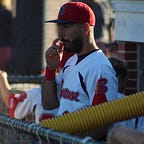Working With The End In Mind
When it comes to building any house or structure the end is pretty clear. You have an ideal in mind and you know roughly what the final product is going to look like. Small adjustments here and there are made by carpenters, finishers, and roofers. Everyone who is involved in the project know what the goal is and how it should look and feel. Pictures may be shown, and blueprints can be drawn with the goal in mind. Architects work with a very specific finished product in mind. They have a final product and can maneuver around that to as they are working to accomplish the goals.
There is no reason for coaches to not do the same. Many times coaches are working so hard to fight against issues that they might see in players that they don’t step back and consider what should be the ideal. Being a coach is a busy job. One that can drag you in so many different directions. We can get so caught up trying to help players make adjustments that we want to see that we often by pass what we want players to be able to do. Making these objectives explicit for all to see. I think that this is one step in the coaching process that should be reevaluated or considered more deeply. Asking yourself what is the ideal that I am looking for in players? By asking this question you will start to get some attributes that you can really focus in on to help you in the coaching process.
The reality is that we as human beings are easily distracted, and influenced by what we see in the moment. Having the ideal that you are wishing to build helps to keep you focused on the task at hand. This blueprinting of sorts also allows you to take a step back and ask what you find important. This moment of thinking helps to shape the development paths that you want out of your players.
In teaching this idea is called backwards design, and I think the concept here is really important to understand. Backwards design works by asking you to consider what you want to happen instead of what do you want to do. Which is a critical difference.
What do you want to do is present focused. What do you see now? Which can sidetrack you from overall goals. When you ask what do you want to do today I think of it similar to the clip below:
You are distracted from your overall goals while focusing on the distractions that pop up in everyday coaching. Backwards design allows us to become more goal focused, outcome oriented, and think long term with development instead of focusing on issues that might be less important to us.
Backwards design essentially asks two really important questions:
- What are the intended results?
- What is acceptable evidence of those results?
Then you take these two questions and start to form a plan. So what you value here is really not as important of the process that you build around these values. I’m not one for absolutes really so if you value something I don’t I really am more interested in the process that you intend to use to get to these results.
What are our intended results?
You are a coach and organization that values more of the Patience Approach to hitting. So you conclude after some debate that you want to put your focus on a few areas of play that you think play into this idea. You want players to be patient at the plate. Avoid striking out. While also successfully reaching base. Maybe you conclude you want to reduce strikeouts and increase walks. Great. You have a framework to now maneuver within.
(What follows depends on level I’m going to use MLB Statistics but please know these should shift in different directions depending on the league and level of play.)
What would be the acceptable evidence of these values?
- .330-.400 On-Base %
- Walk Rate between 10% to 15%
- K% between 10% to 15%
It sets a clear bar that we want athletes to clear. There is very little ambiguity of what is expected of players if this was the case. The values are spelt out and we can continue to build this idea out. What this now does for us is allows us to take what we value and start to plan out experiences and instruction that is related to these values. All the while knowing that what you are working on is related to Ideal Athlete.
I think that this type of idea can be scaled up or down depending on your comfort, and level of play. Really what you need to take away is that looking for the end goal should be your first priority and then plan your coaching around that.
